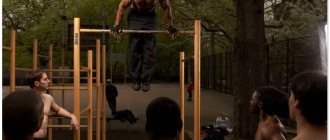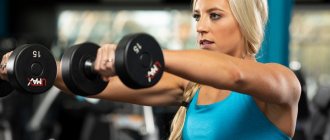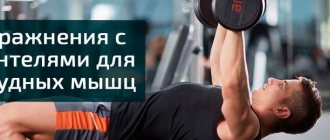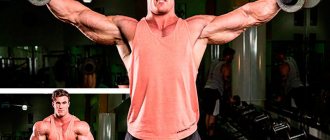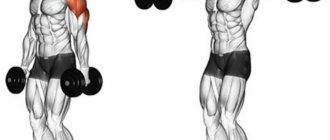In the process of building muscle, bodybuilders use high-volume training methods in the form of supersets and dropsets. This article aims to familiarize readers with training the deltoid muscles using conventional supersets and trisets. Classic supersets allow you to perform 2 exercises without stopping. With the use of a triset, it becomes possible to add one more exercise. This training program can be useful for any category of athletes whose deltoid muscle is lagging behind in gaining mass or has stopped developing.
The shoulder girdle, by itself, does not have a large number of muscles, so training these muscles is not carried out separately, but together with training other muscle groups. Typically, shoulders are trained along with leg training, back is trained with biceps, and chest is trained with triceps. In this case, it makes sense to familiarize yourself with the training process of the deltoid muscles based on supersets.
Goal: gain shoulder muscle mass
To build muscle, always start your workout with the most difficult exercises—multi-joint overhead presses, in the case of delt training—that will allow you to lift the maximum weight.
In this muscle-building workout, the first compound exercise is followed by a second compound exercise, followed by isolation movements for each of the three deltoid heads: anterior, middle, and posterior. Keeping your overall training volume high also promotes muscle growth.
You can make your workout more challenging in several ways. For the overhead press, start by using dumbbells, which are a little more difficult to control and allow for a greater range of motion than a barbell. You will also follow a reverse pyramid scheme, which will allow you to increase the number of repetitions, bringing the muscle closer to failure.
For the first two sets, use a fairly heavy weight and work in the lower rep range—6 total—to achieve greater strength gains than you could get with slightly higher reps and lighter weights.
Read also: Shoulder workout from IFBB Bikini pro Amy Updike.
As your muscles become tired and fatigued, reduce the weight by about 5 kilograms or 2.5 per side in subsequent approaches. Finally, on the two hardest sets, especially the last one, enlist the help of a partner so you can squeeze in the final reps.
Since the front delts get plenty of work on chest day and the middle delts take the brunt of the overhead press, it's not uncommon for the rear delts to be left out.
In this workout, you'll train them before the other two while you have a little more energy. However, feel free to change the order of the isolation exercises in this circuit based on your weak areas. If you think your deltoids are well-balanced, simply vary the order of isolation movements from one workout to the next.
Workout 1: Increase Shoulder Muscle Mass
- Seated dumbbell press – 4 sets of 6, 6, 8, 10 reps (rest 2 minutes)
- Wide grip barbell row – 3 sets of 8, 8, 10 reps (rest 2 minutes)
- Seated dumbbell raises – 3 sets of 8, 10, 12 reps (rest 1 minute)
- Standing dumbbell lateral raises – 3 sets of 8, 10, 12 reps (1 minute rest)
- Lifting the barbell in front of you – 3 sets of 8, 10, 12 repetitions (rest between 1 minute)
What is a drop set in bodybuilding?
Drop sets are a training method in which you perform a set of any exercise to failure, then reduce the weight on the apparatus and perform more repetitions. According to Arnold's Encyclopedia of Modern Bodybuilding, the method was originally discovered in 1947 by Henry Atkinson, editor of Body Culture magazine. Atkins called this training a “multi-weight system.” Many years have passed, and this mass-gaining technique has gone by many names: crushing, triple drops, drop sets, weight drops, strip sets, and the weight drop method.
Goal: relief of the deltoid muscles
Lifting light weights for high reps is no longer considered the best approach for getting deltoid definition.
This workout focuses on increasing shoulder size (moderate weight, moderate reps) and then high training volume of work combined with supersets to increase the number of calories burned both during and after the workout (called excess post-exercise oxygen consumption or EPOC , English excess postexercise oxygen consumption - the amount of oxygen required to oxidize the under-oxidized metabolic products accumulated in the body during intense muscular work, also called oxygen debt)
Workout 2: Deltoid Definition
Normal execution
- Seated barbell press – 4 sets of 8-12 reps (rest 2 minutes)
Superset
- Standing dumbbell lateral raises – 3 sets of 10-12 reps (no rest)
- Seated bent over raises with dumbbells – 3 sets of 10-12 reps (rest 60-90 seconds)
Superset
- Raising your arms in front of you from the lower block – 3 sets of 10-12 repetitions (without rest)
- Vertical row from the lower block - 3 sets of 10-12 reps (rest 60-90 seconds)
Superset
- Arm raises in the Peck Deck simulator – 3 sets of 10-12 repetitions (without rest)
- Lateral raises using an expander or rubber band - 3 sets of 10-12 reps (rest 60-90 seconds)
Goal: to create a foundation for beginners
This basic workout consists of one overhead press and an isolation exercise for each of the three deltoid heads. For the first exercise, use a machine to get a feel for the movement before moving on to free weights.
Read also: How wide should your grip be when performing standing vertical rows?
Although moving to free weights will be a challenge for your coordination at first, it is better for gaining muscle mass in the long run. Start with light weights so you can focus on proper technique first. Add weight only when you have full control of the movement.
Workout 3: For Beginners
- Seated overhead press – 3 sets of 12 reps (rest 60-90 seconds)
- Standing dumbbell lateral raises – 3 sets of 12 reps (rest 60-90 seconds)
- Raising your arms in front of you from the lower block – 3 sets of 12 reps (rest 60-90 seconds)
- Peck Deck Raises – 3 sets of 12 reps (rest 60-90 seconds)
Goal: development of the middle deltoid fascicle
To make your shoulders look wider, you need to emphasize your middle deltoids. This in turn helps create a V-shaped torso, creating the illusion of a narrow waist. Of course, the key to this kind of training is to do more exercises that target the middle deltoids.
In addition to the core exercises, you can use different angles of isolation movements for different training stimuli and perform such exercises with a moderate body displacement earlier in the training when your strength level is highest.
You can alternate this workout in your weekly split with a more balanced delt workout that hits all three heads evenly (such as Workout 1).
Workout 4: Focus on Middle Delts
- Standing barbell press – 4 sets of 8 reps (rest 2 minutes)
- Vertical barbell row – 3 sets of 8-10 reps (rest 60-90 seconds)
- Side dumbbell raise with one arm while standing with a slight bend to the side - 3 sets of 10 repetitions with each arm (rest 60-90 seconds)
- Standing dumbbell lateral raises – 3 sets of 10-12 reps (rest 60-90 seconds)
Super and drop sets
What is a superset? This is alternating different exercises in one approach. This strategy allows you to increase and diversify the load on the muscles at the same time, saving time and increasing the effectiveness of the exercises. For the shoulders, a superset can be pumping the front and rear deltoid muscles or alternating different exercises for the middle parts of the deltoid. There can be either two or three exercises - in this case, one superset will allow you to work out the entire delta at once - its rear, middle and front bundles. This will be a very intense set, so don't do too many repetitions.
A drop set is a training strategy where the working weight and number of repetitions are reduced with each approach by 20-25%, while doing no more than 8 approaches in total without a break. It is better to leave the dropset for the final stage of training. As a rule, it is performed for different bundles of the deltoid muscle. In turn, a drop set means reducing the working weight and increasing the number of repetitions from approach to approach. In each approach, up to 20-25% of the weight is dropped, a total of 6-8 approaches of the exercise are performed without a break. The dropset and associated pumping are the best completion of shoulder training. and, as a rule, each dropset workout is performed on different delta beams.
Goal: development of the posterior deltoid bundle
The rear delts tend to lag in both beginners and advanced bodybuilders. Simply put, they don't get the same stimulation as the front and middle deltoids, which are heavily worked in chest exercises and multi-joint shoulder movements.
The rear delts get an indirect load on back day, but still, too many lifters focus on working the “mirror” muscles.
If your rear delts are underdeveloped, simply follow this routine for 4-8 weeks, or alternate it with a more balanced shoulder routine.
Workout 5: Focus on the rear delts
- Seated dumbbell press – 4 sets of 8-10 reps (rest 2 minutes)
- Dumbbell flyes lying chest down on an incline bench – 4 sets of 8-10 reps (rest 60-90 seconds)
- Crossover raises from overhead blocks – 3 sets of 10 reps (rest 60-90 seconds)
- Peck Deck Raises – 3 sets of 10-12 reps (rest 60-90 seconds)
Read also: Shoulder workout: 400 repetitions.
Features of shoulder training using supersets
A shoulder superset is shock therapy for both the muscles and the body as a whole.
The main purpose is to shake up the body, accustomed to the same type of loads, and give a new impetus for muscle growth.
But such stress should not last long, otherwise there is a high risk of overtraining and stagnation in results.
It is optimal to limit the application cycle to 3-4 weeks, after which again move on to traditional methods.
Supersets are definitely not suitable for beginners. Their shoulders grow well even from classical loads.
But they will help the intermediate and experienced level to advance in their progress.
Goal: development of the anterior deltoid bundle
If you're training your chest, you probably already have well-developed front deltoids. After all, they work in all chest exercises, especially those performed on an incline.
But relatively weak front delts will keep you from getting a bigger chest, so here's a workout that focuses on the front delts that you can use instead of a regular shoulder workout.
Divide your workouts between chest and shoulders, especially focusing on the front deltoids, leaving at least 48 hours between them to allow them to fully recover between sessions.
Workout 6: Focus on the front delts
- Standing barbell press – 4 sets of 8-12 reps (rest 2 minutes)
- Arnold press – 4 sets of 8-12 reps (rest 2 minutes)
- Raising dumbbells in front of you - 3 sets of 10 reps (rest 60-90 seconds)
- Raising your arms in front of you from the lower block - 3 sets of 10-12 repetitions (rest 60-90 seconds)
Basic exercises
You need to start training with basic exercises. Let's consider them further.
Sitting lat pulldown to the chest
This exercise is the main one for pumping up the shoulder sector and muscles. The goal is to expand and tighten the muscles of the back and deltoids (shoulders).
When performing this exercise, you need to focus on the work of these muscles. If you include biceps in the work, you will not get the desired effect from the workout.
Performance:
- You need to grasp the bar with straight hands; bending them is not recommended.
- Hands should be used as hooks. In this case, use only the forearms and broad muscles.
- Try to take this position, while contracting the broad muscles as much as possible, and then slowly return to the starting position.
- First, do ten to fifteen reps to warm up using light weights.
- Next, do three heavy sets, gradually increasing the weight.
Previously, we told you how to pump up your breasts.
Raising dumbbells to the sides while bending forward
This will help you tone your shoulders and back in the best possible way.
Performance:
- To perform this exercise in a standing position, you first need to slightly spread your legs and bend your knees.
- The torso needs to be tilted forward, arching your back at this time.
- Dumbbells should be held in hands that are slightly bent at the elbows.
- You need to inhale and move the dumbbells to the sides.
- After completing the reverse movement, exhale.
This exercise mainly works only the deltoids, especially the back of them.
By bringing your shoulder blades together at the end of the session, you also activate the lower and middle parts of the trapezius muscles of the back.
The same exercise can be performed while lying on an inclined bench, resting your chest against it.
Vertical thrust
This is another effective exercise for pumping up your shoulders and back muscles.
Performance:
- To perform it, you need to take a standing position and place your feet shoulder-width apart. The back should be straight, and the bar of the barbell should be located below, near the hips, with an overhand grip.
- Next, you need to inhale and stretch the bar up along your body, while raising your elbows to their maximum height, until the bar touches your chin.
- Then you need to slowly return to the starting position, while gradually straightening your arms.
- After finishing, exhale.
While performing the exercise, try not to make sudden movements.
It mainly works the upper trapezius muscles of the back and the deltoids, brachialis and forearm muscles.
It trains the sacrolumbar muscles and buttocks less.
Keep in mind that the wider the grip, the more the deltoids will be activated, and the less the trapezius.
In another article, we discussed how to remove belly and sides.
Goal: pre-tire the deltoids
As with training the pectoral muscles, the triceps can sometimes be the limiting factor when training the shoulders, especially when performing presses.
If your triceps always tire before your shoulders get the proper load, you'll never be able to push your delts to failure.
The pre-fatigue method solves this problem. Here you do isolation exercises for the delts first, and then move on to perform basic pressing movements while the triceps are still strong. Thus, the deltoids will fail before the triceps.
Even though your delts will be fresh and strong when doing isolation exercises because you're doing them first, avoid the temptation to lift heavy because of the added stress on your elbow joints.
Also, since your muscles will already be pretty tired by the time you get to the compound exercises, the machine version of the overhead press may be a little safer.
By switching the exercise order, your muscles will be a little stronger on the isolation movements, but a little weaker on the overhead press, so adjust the weight accordingly.
Workout 7: Pre-Exhaustion Method
- Lateral arm raise from the lower block – 4 sets of 8-10 repetitions with each arm (rest 60-90 seconds)
- Lifting the barbell in front of you with straight arms – 3 sets of 10 repetitions (rest 60-90 minutes)
- Peck Deck Raises – 3 sets of 10 reps (rest 60-90 seconds)
- Machine overhead press – 3 sets of 8-10 reps (rest 2 minutes)
- Vertical barbell row – 3 sets of 10-12 reps (rest 2 minutes)
Why do bodybuilders like drop sets?
Bodybuilders are unique representatives of the sports and athletic environment because they are no longer associated with athletic ability, but with aesthetic improvement. Therefore, bodybuilders love to do drop sets due to the fact that this method directly provokes muscle hypertrophy. You're unlikely to see soccer players, sprinters, and other athletes doing drop sets with ease because the method doesn't help increase strength, speed, or endurance. In fact, many athletes do not need beautiful body proportions, so they refuse drop sets. However, if your goal is to gain quality muscles, then a drop set for mass will certainly help you!
